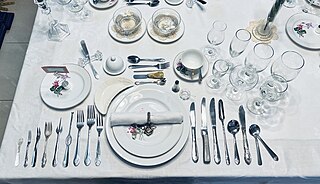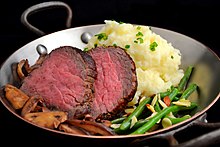Brunch is a meal, sometimes accompanied by alcoholic drinks, taken sometime in the late morning or early afternoon – the universally accepted time is 10am-1pm. The meal originated in the British hunt breakfast. The word brunch is a portmanteau of breakfast and lunch. The word originated in England in the late 19th century, and became popular in the United States in the 1930s.
Supper is used commonly as the term for the main evening meal, although its use varies considerably. Supper may be used to describe a light snack or meal in the evening, either after or instead of dinner.
Breakfast is the first meal of the day usually eaten in the morning. The word in English refers to breaking the fasting period of the previous night. Various "typical" or "traditional" breakfast menus exist, with food choices varying by regions and traditions worldwide.
The following outline is provided as an overview of and topical guide to meals:
Elevenses is a short break taken at around 11:00 a.m. to consume a drink or snack. The names and details vary among countries.

A cafeteria, sometimes called a canteen outside the U.S. and Canada, is a type of food service location in which there is little or no waiting staff table service, whether in a restaurant or within an institution such as a large office building or school; a school dining location is also referred to as a dining hall or lunchroom. Cafeterias are different from coffeehouses, although the English term came from the Spanish term cafetería, which carries the same meaning.

Service à la française is the practice of serving various dishes of a meal at the same time, with the diners helping themselves from the serving dishes. That contrasts to service à la russe in which dishes are brought to the table sequentially and served individually, portioned by servants.

A buffet can be either a sideboard or a system of serving meals in which food is placed in a public area where the diners serve themselves. A form of service à la française, buffets are offered at various places including hotels, restaurants, and many social events. Buffet restaurants normally offer all-you-can-eat food for a set price, but some measure prices by weight or by number of dishes. Buffets usually have some or mostly hot dishes, so the term cold buffet has been developed to describe formats lacking hot food. Hot or cold buffets usually involve dishware and utensils, but a finger buffet is an array of foods that are designed to be small and easily consumed only by hand, such as cupcakes, slices of pizza, foods on cocktail sticks, etc.

A chafing dish is a metal cooking or serving pan on a stand with an alcohol burner holding chafing fuel below it. It is used for cooking at table, notably in Gueridon service, or as a food warmer for keeping dishes at a buffet warm.

A full-course dinner is a meal with multiple courses, almost invariably eaten in the evening or afternoon. Most Western-world multicourse meals follow a standard sequence, influenced by traditional French haute cuisine. It commonly begins with an appetizer, followed by the main course, the salad course, and eventually the dessert, but the exact sequence varies widely. Full-course dinners are generally very formal as well as very expensive, and can have as few as 3 or as many as 21 courses. Some major styles include service à la russe and service à la française.
Sara's Secrets was a Food Network show hosted by Sara Moulton who was the executive chef of Gourmet magazine. Sara’s Secrets aired from 2002 until 2007. Sara's Secrets offers the viewer recipes and techniques specifically focused to fit the viewer's busy lifestyle.

A state banquet is an official banquet hosted by the head of state in his or her official residence for another head of state, or sometimes head of government, and other guests. Usually as part of a state visit or diplomatic conference, it is held to celebrate diplomatic ties between the host and guest countries. Depending on time of the day, it may be referred to as a state dinner or state lunch. The size varies, but the numbers of diners may run into the hundreds.
Restaurants fall into several industry classifications, based upon menu style, preparation methods and pricing, as well as the means by which the food is served to the customer. This article mainly describes the situation in the US, while categorisation differs widely around the world.

Merienda is a light meal in southern Europe, particularly Spain, Portugal and Italy (merenda), France (goûter), as well as Hispanic America, the Philippines (meryenda/merienda), North Africa , and Brazil. Usually taken in the afternoon or for brunch, it fills in the meal gap between the noontime meal and the evening meal, being the equivalent of afternoon tea in the English-speaking world; or between breakfast and lunch. It is a simple meal that often consists of a piece of fruit, bread, biscuits, yogurt, and other snacks accompanied by fruit juice, milk, hot chocolate, coffee, spirits, or other beverages.
Lunch is a meal eaten around the middle of the day. It is commonly the second meal of the day, after breakfast, and varies in size by culture and region.

Tea has long been used as an umbrella term for several different meals. English writer Isabella Beeton, whose books on home economics were widely read in the 19th century, describes meals of various kinds and provides menus for the "old-fashioned tea", the "at-home tea", the "family tea", and the "high tea".

Smörgåsbord is a buffet-style meal of Swedish origin. It is served with various hot and mainly cold dishes.
The following outline is provided as an overview of and topical guide to cuisines:

A meal is an eating occasion that takes place at a certain time and includes consumption of food. The names used for specific meals in English vary, depending on the speaker's culture, the time of day, or the size of the meal.






















